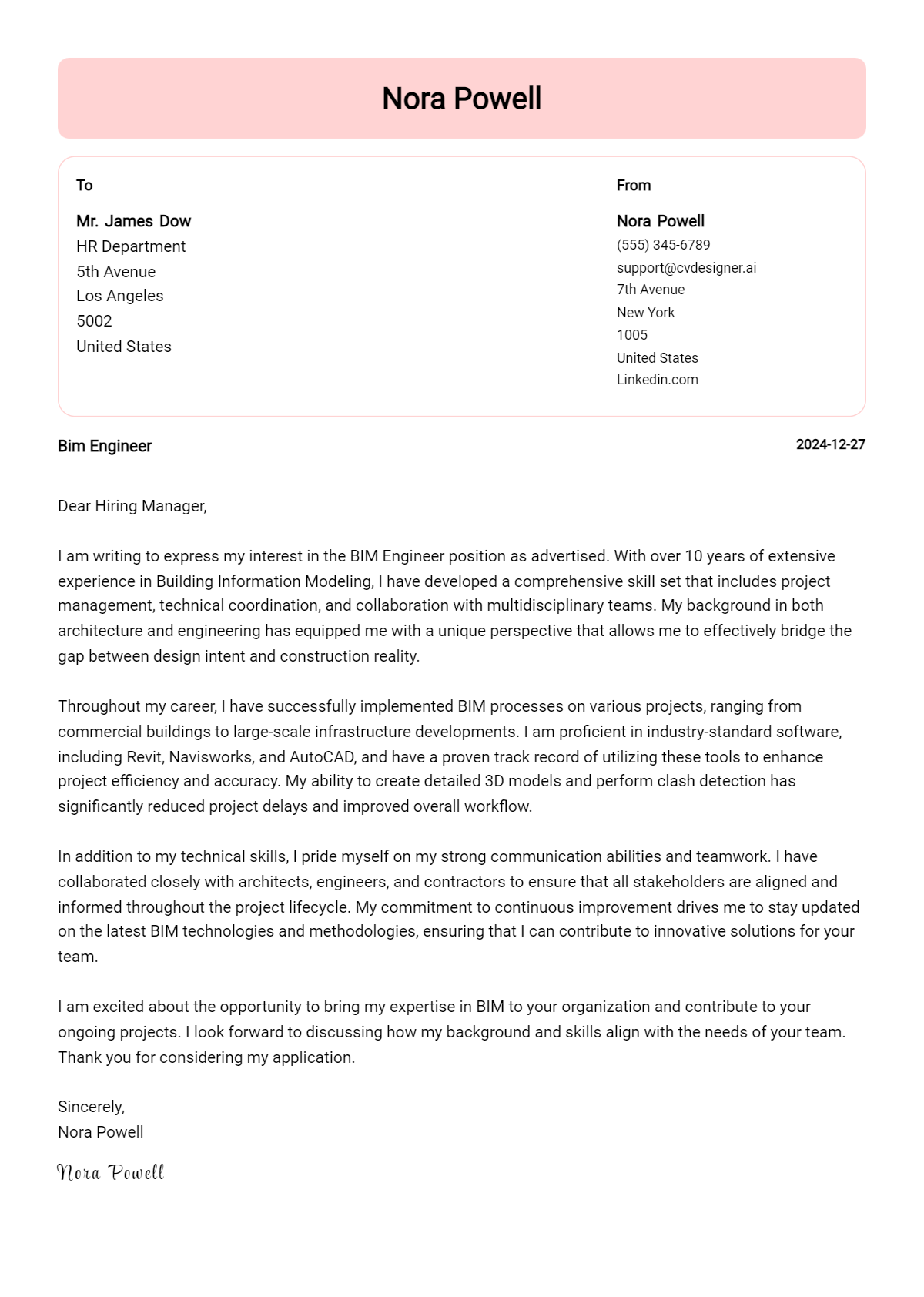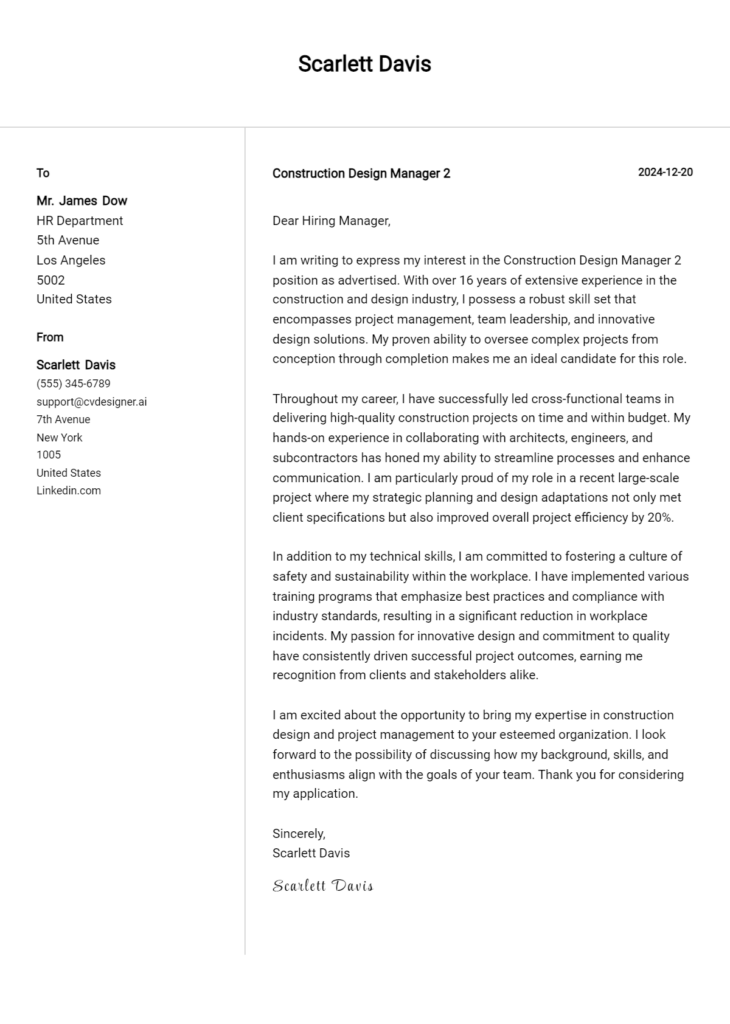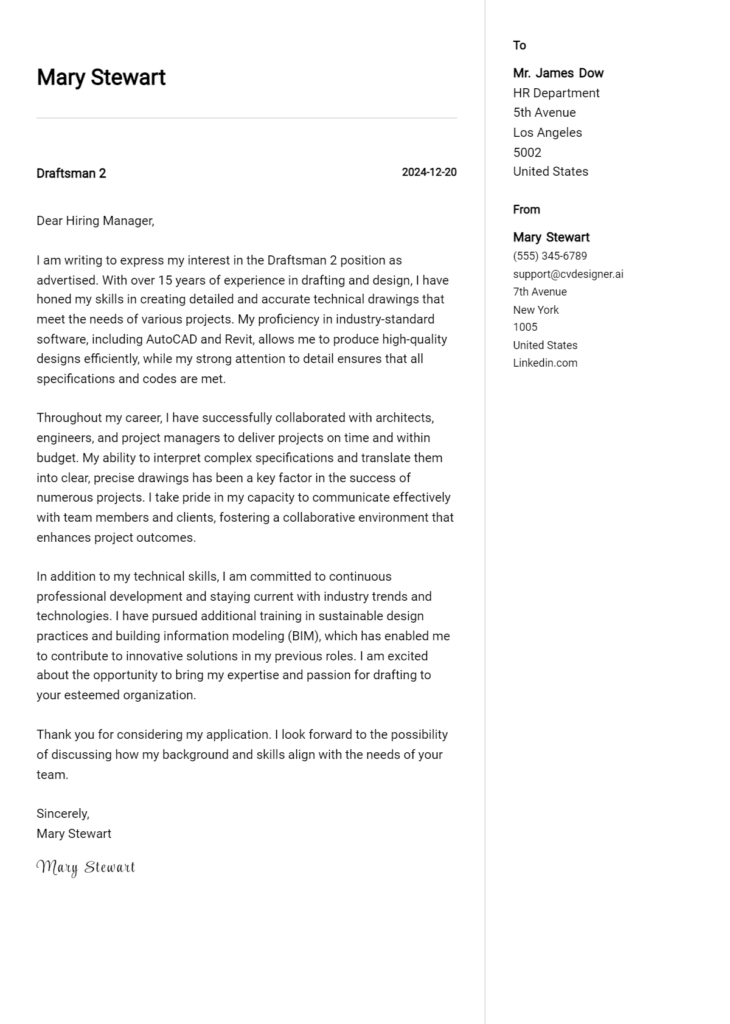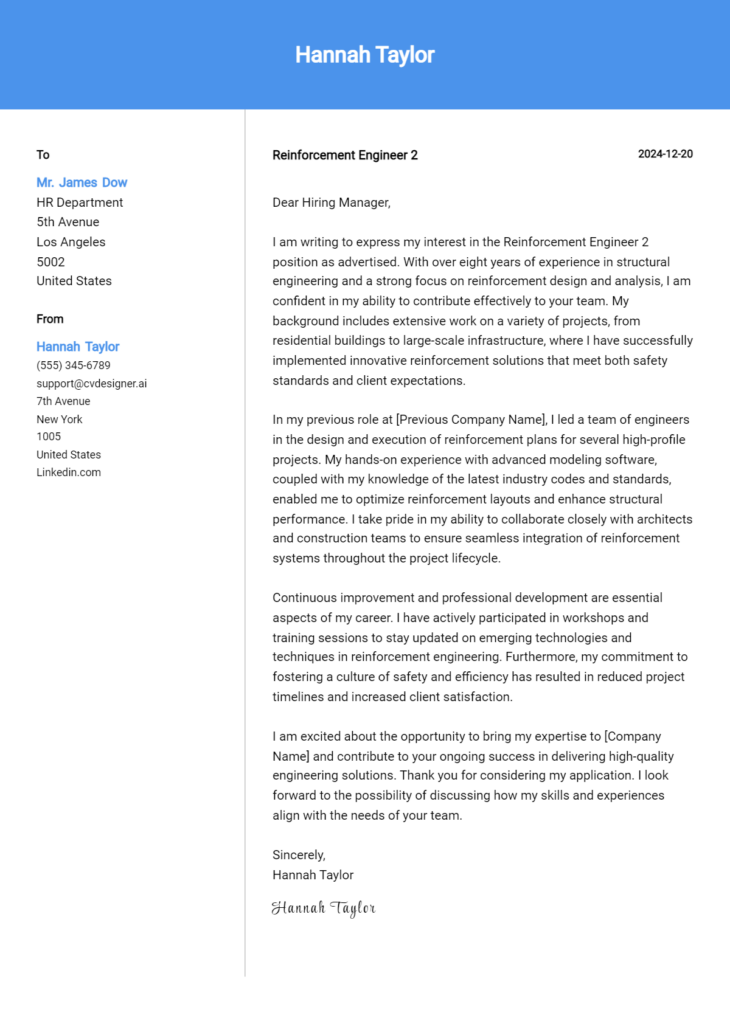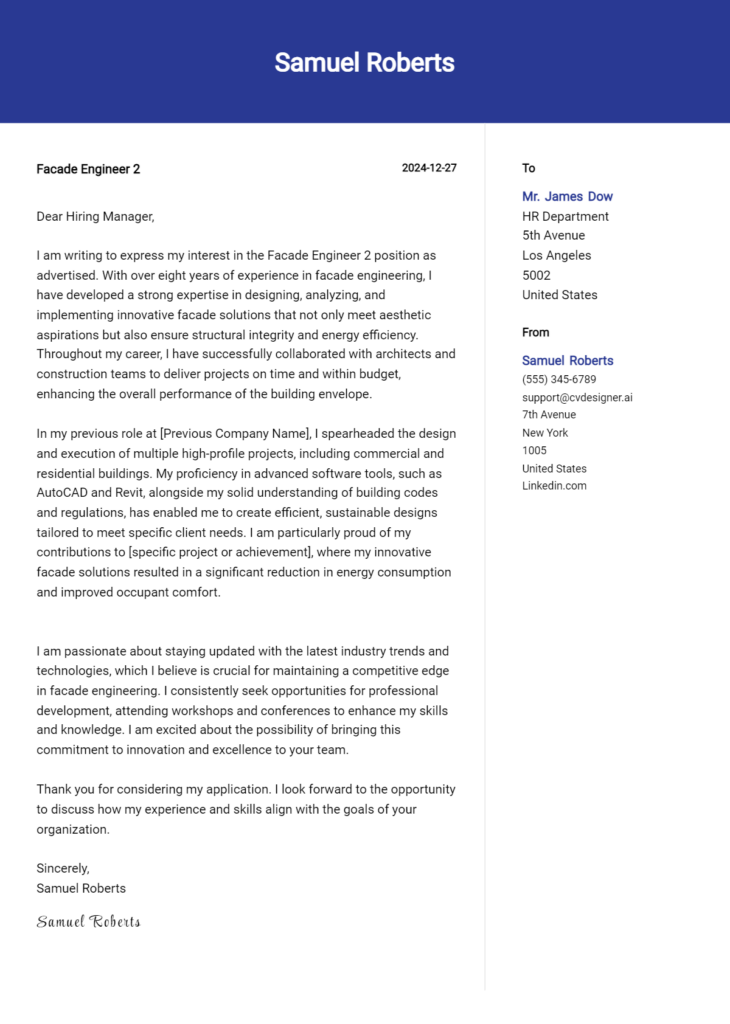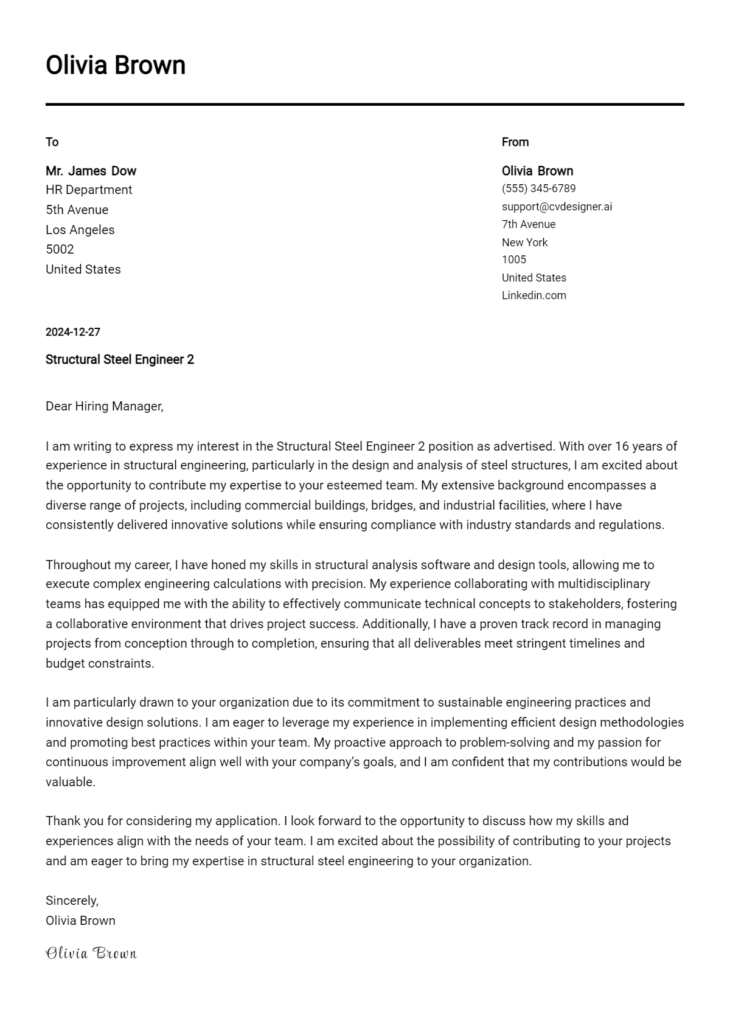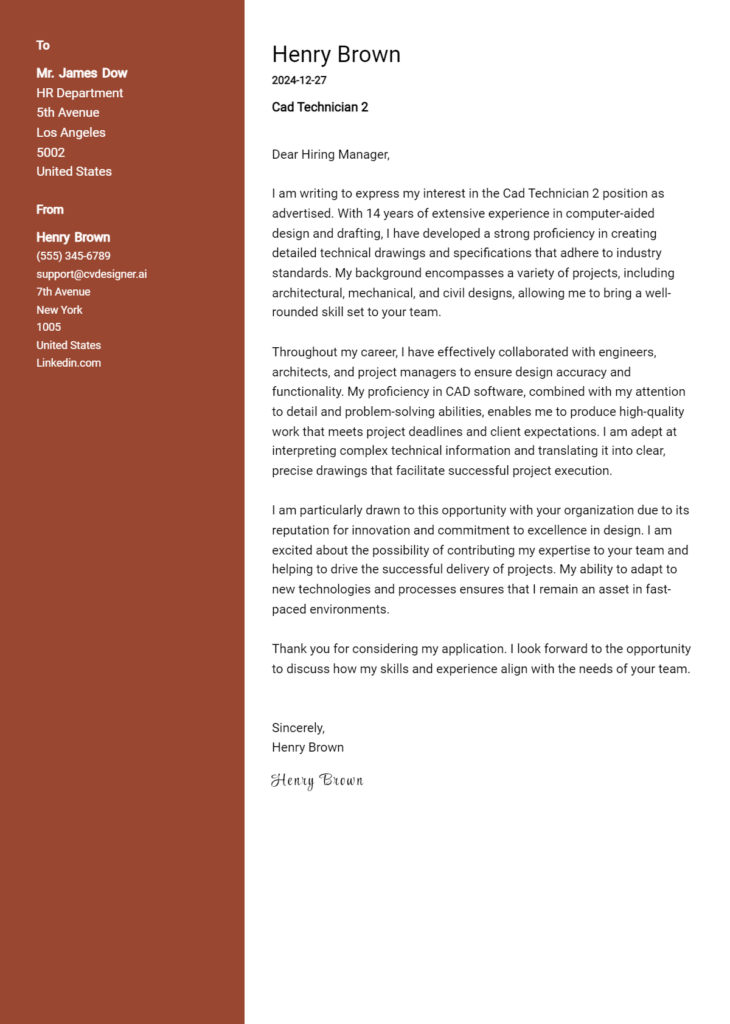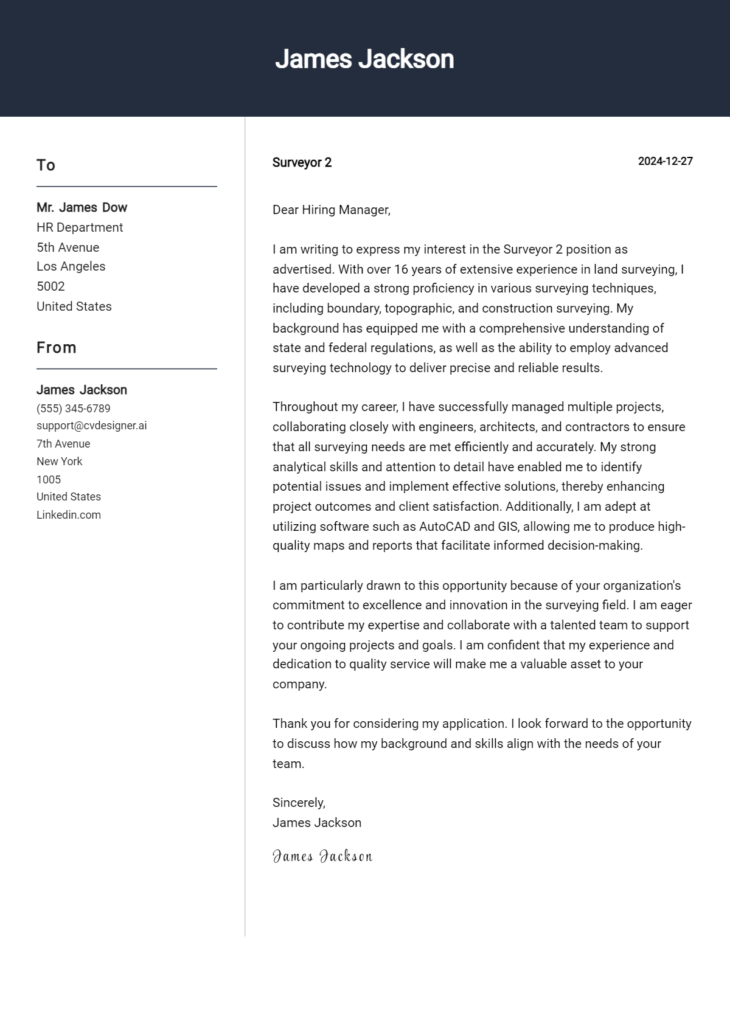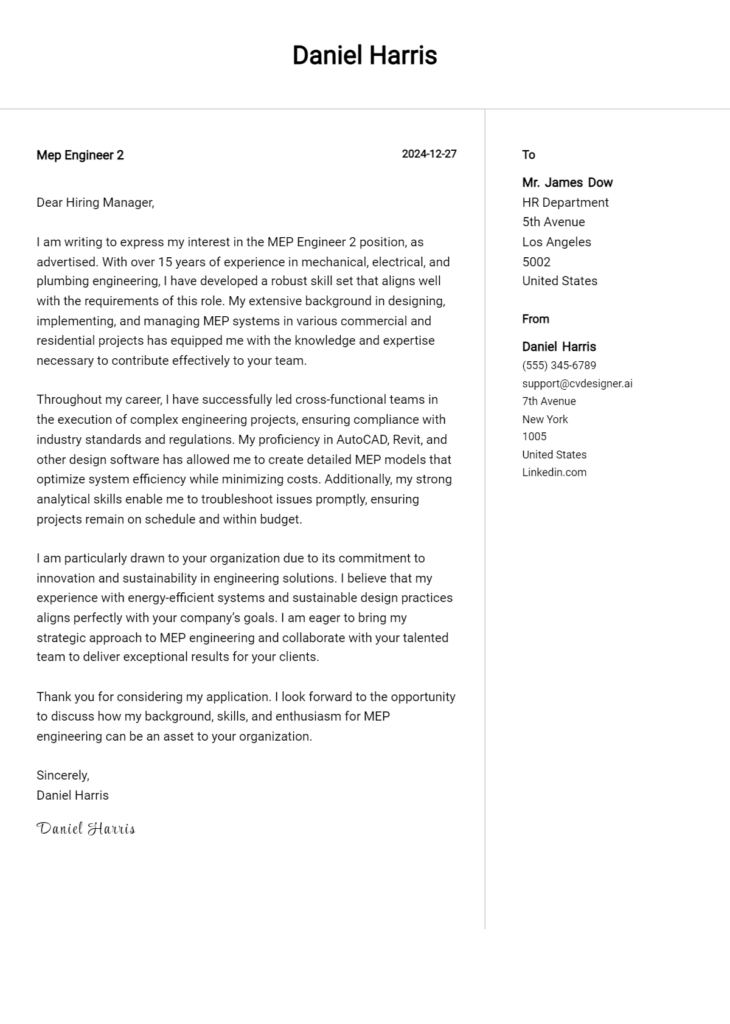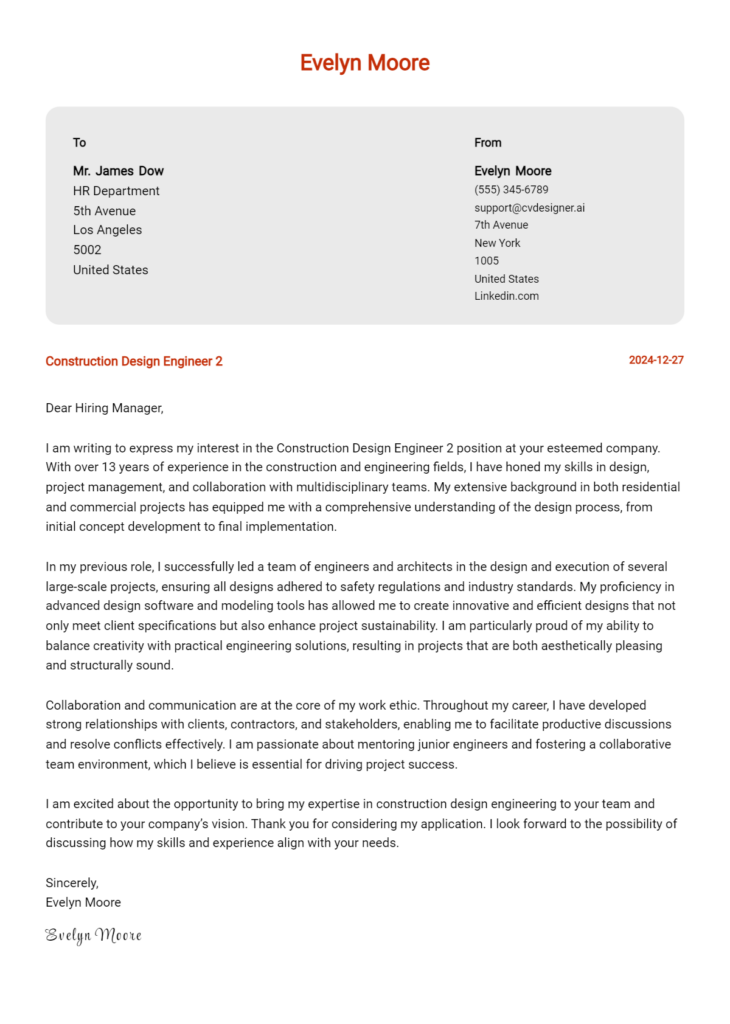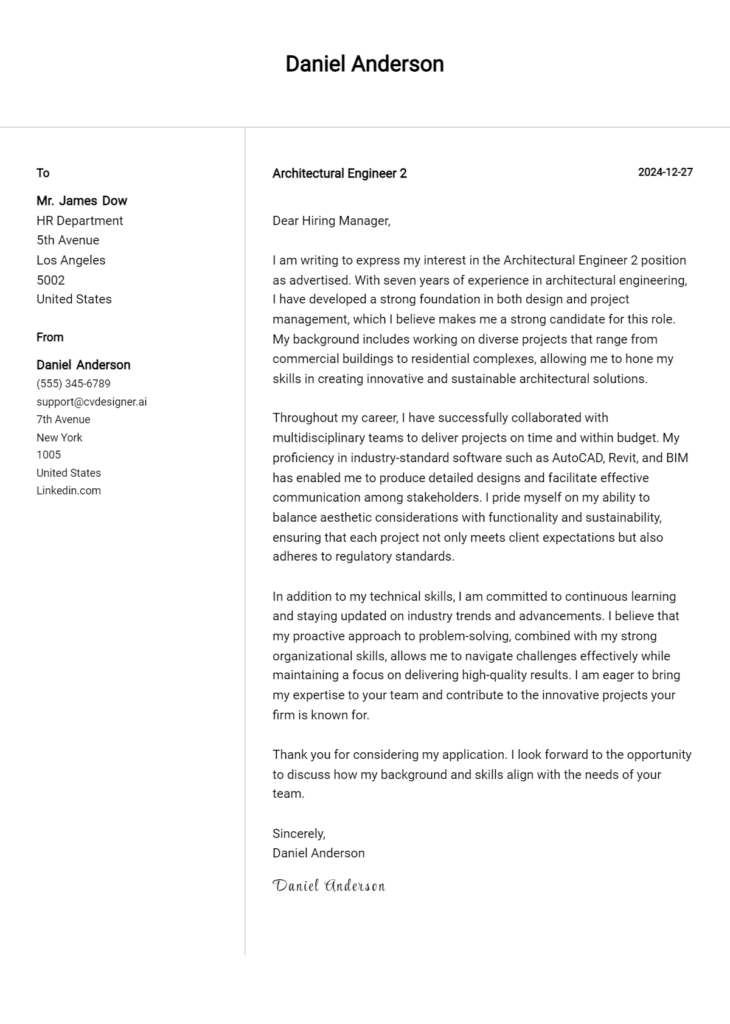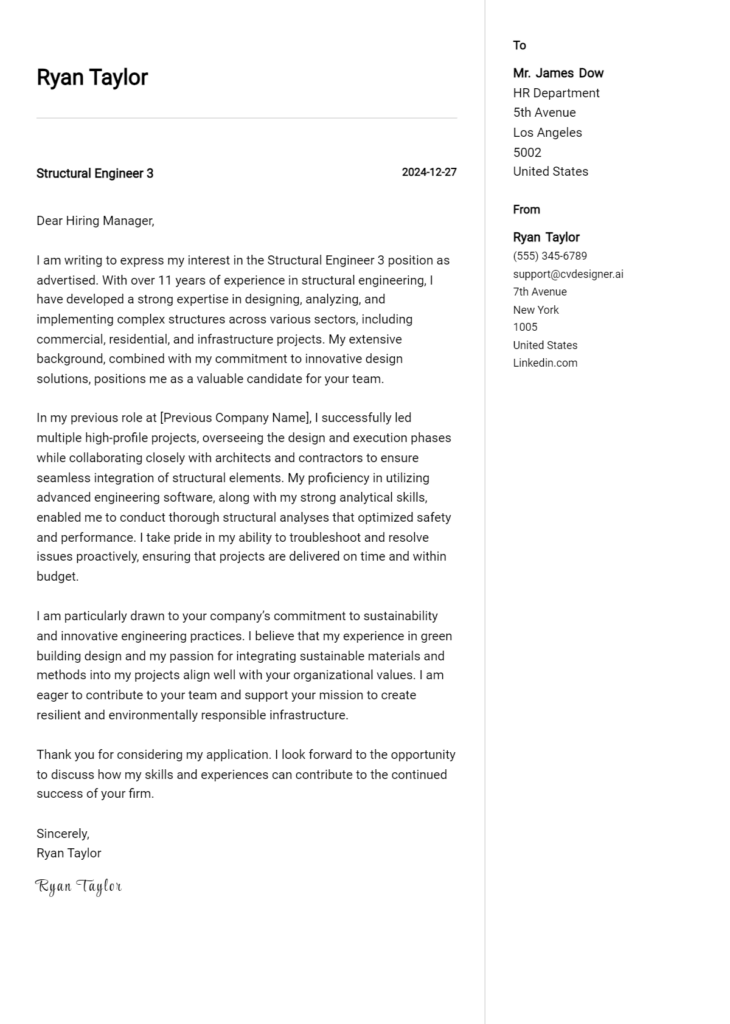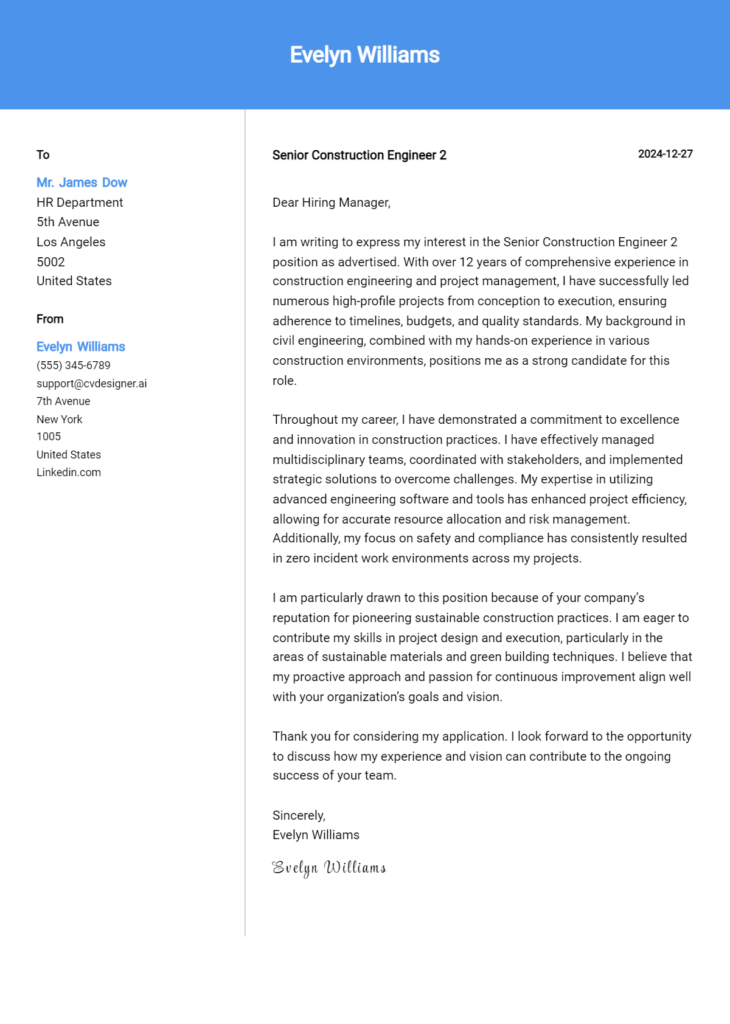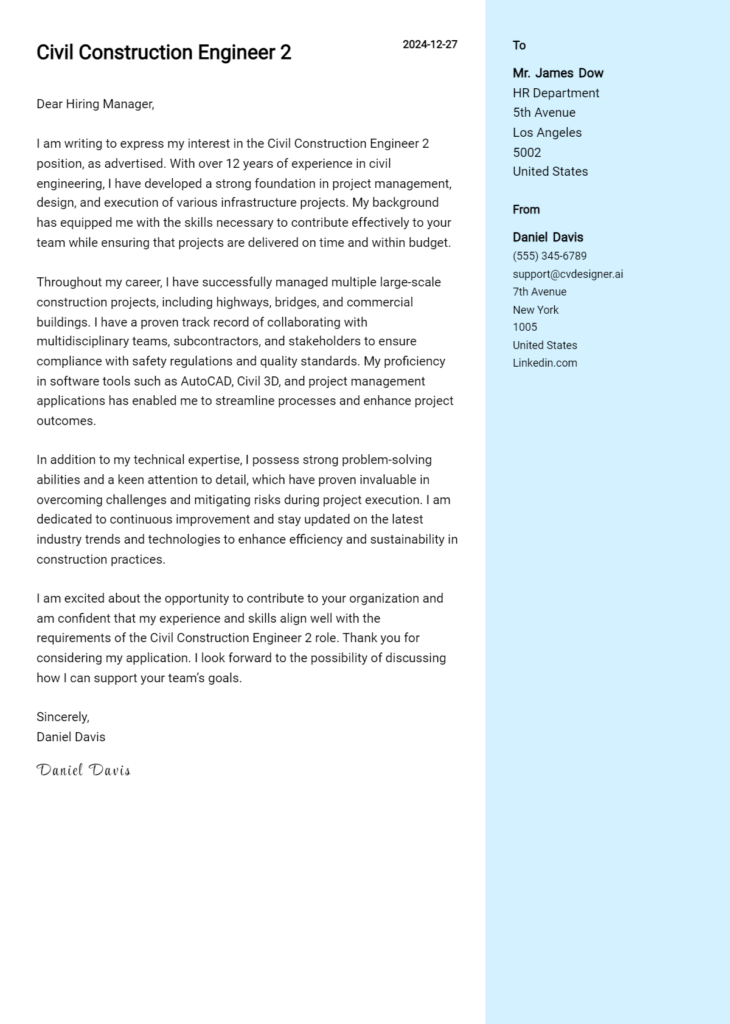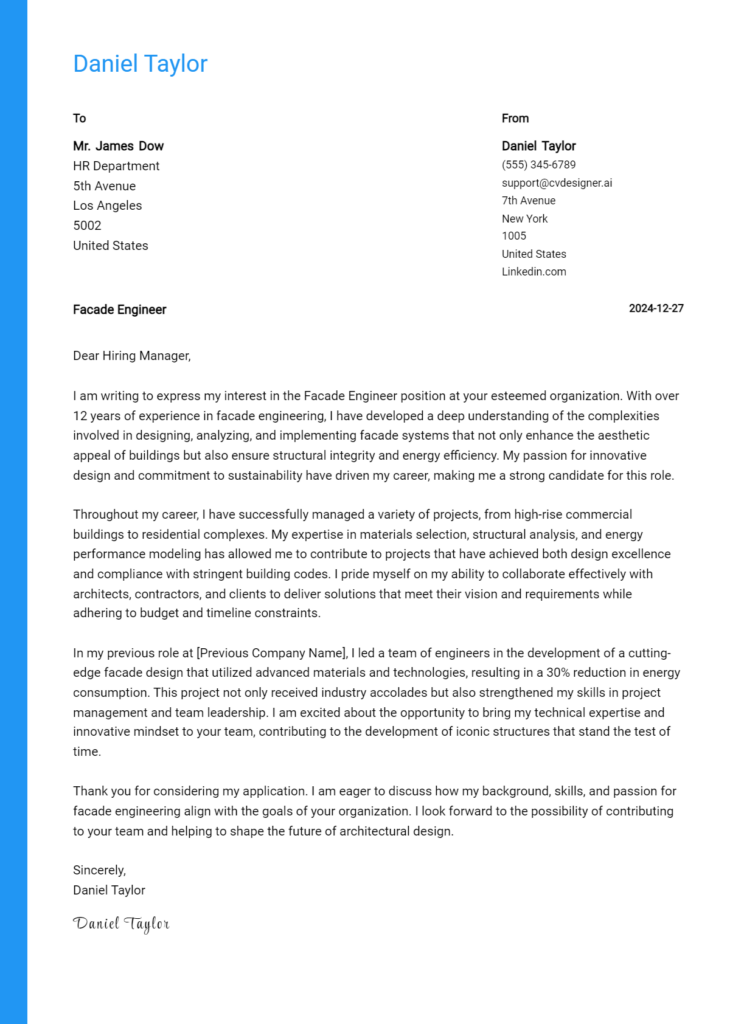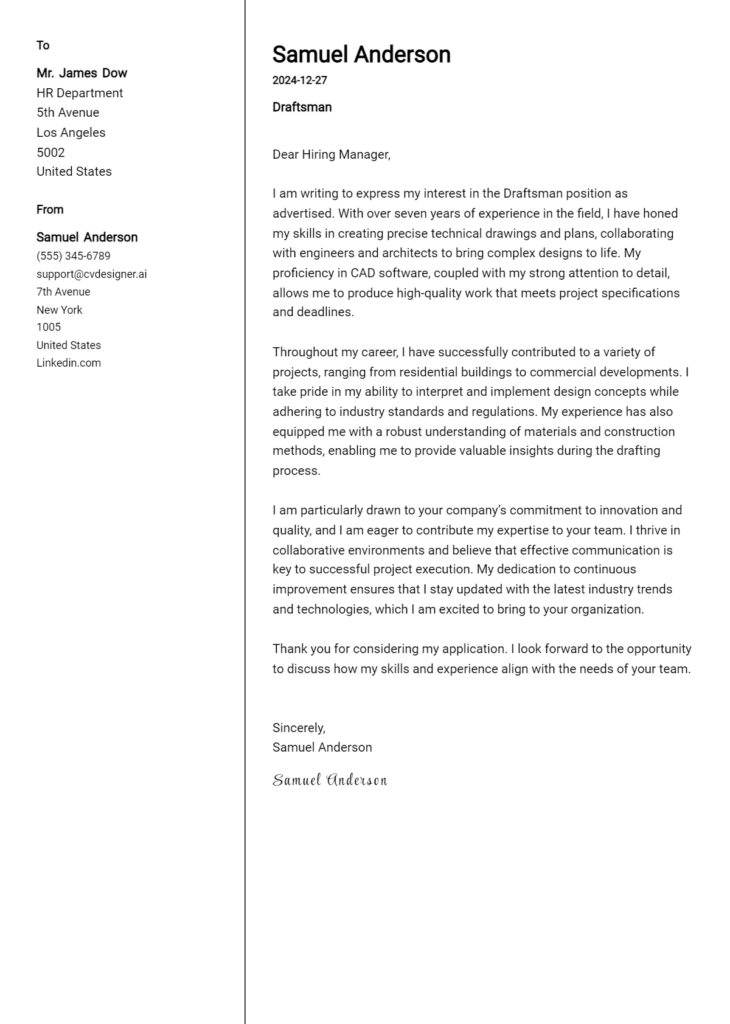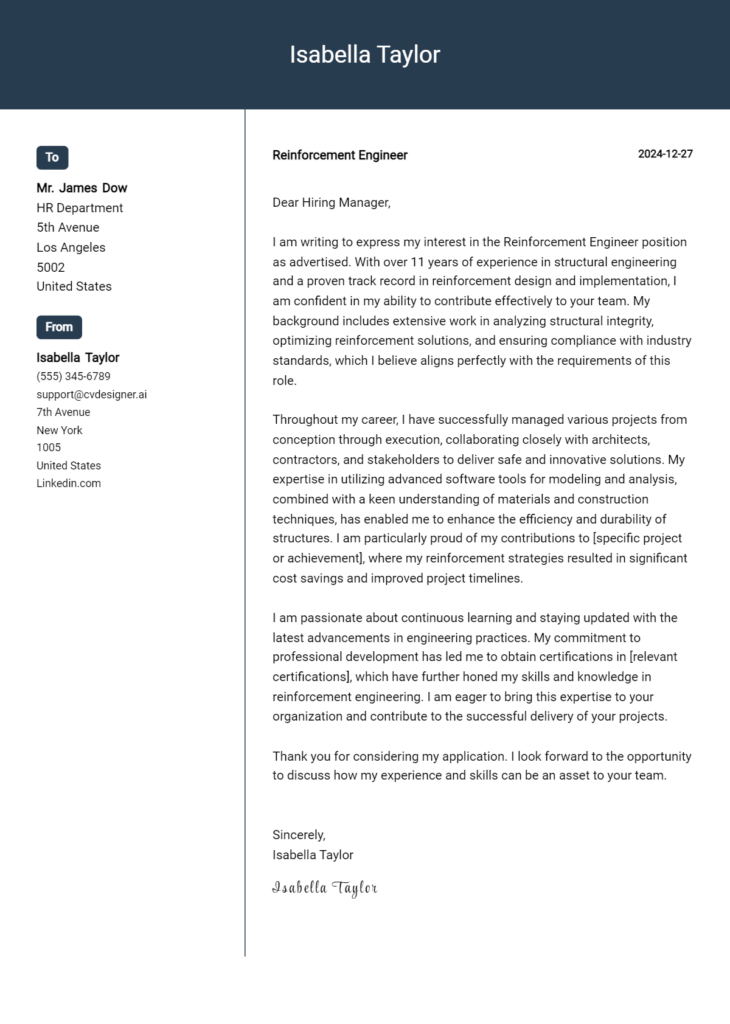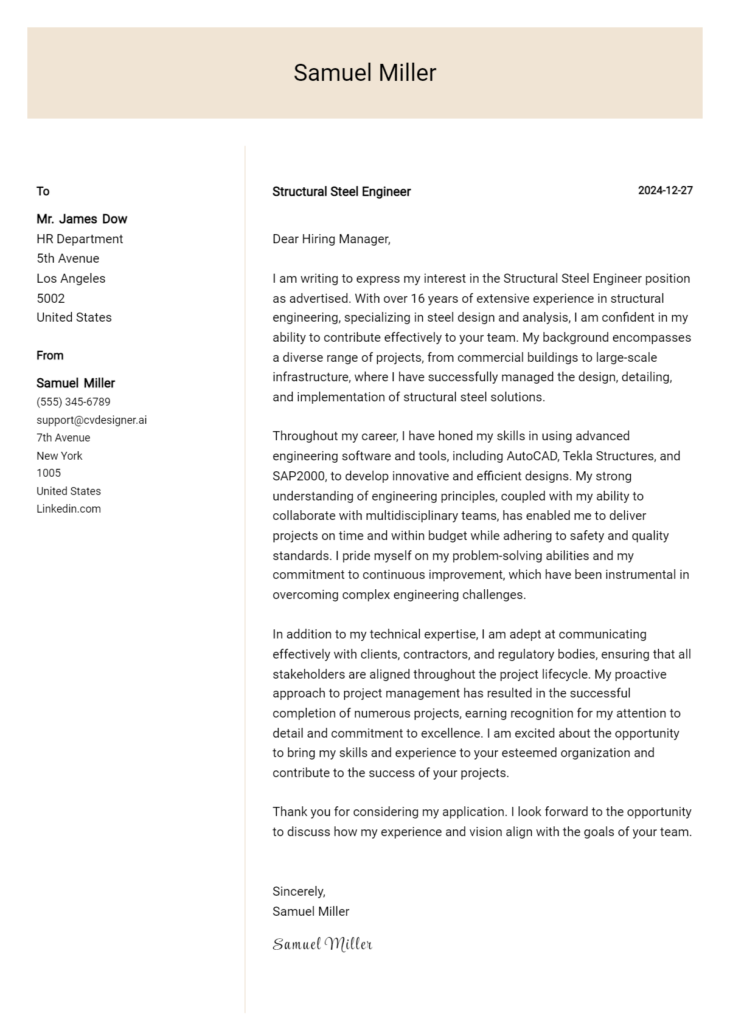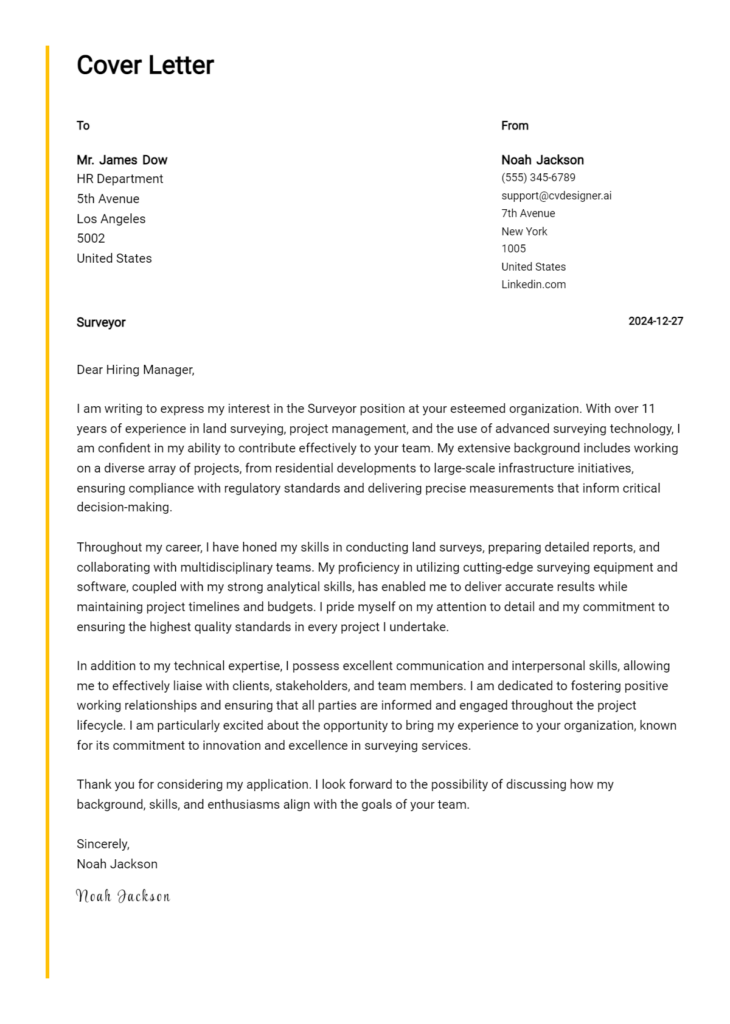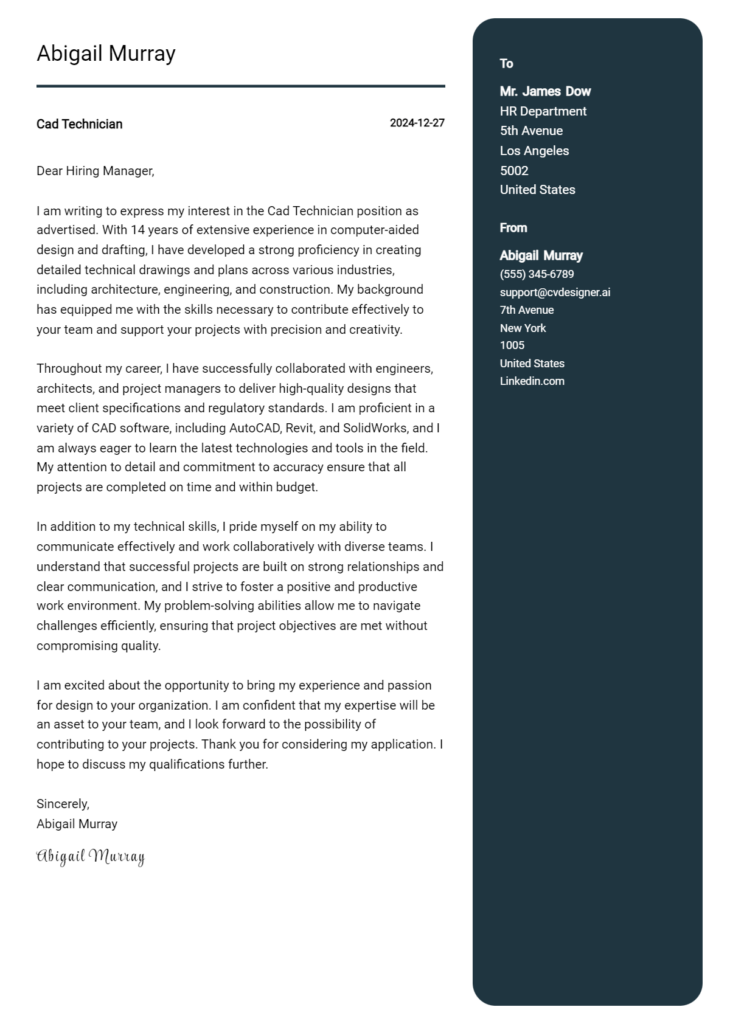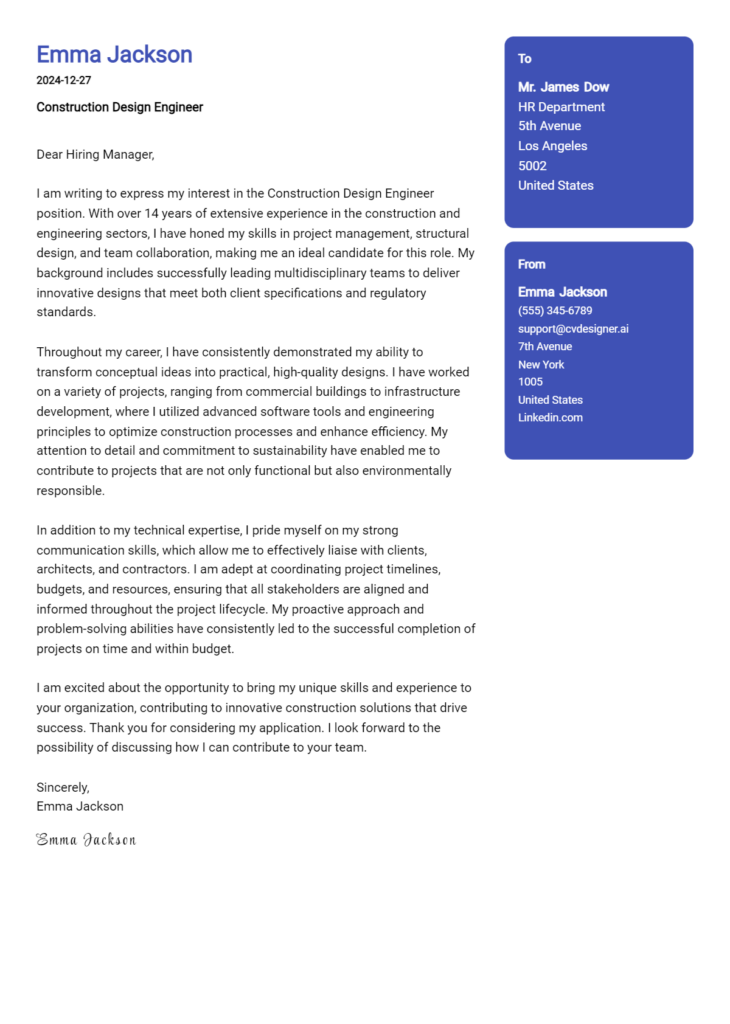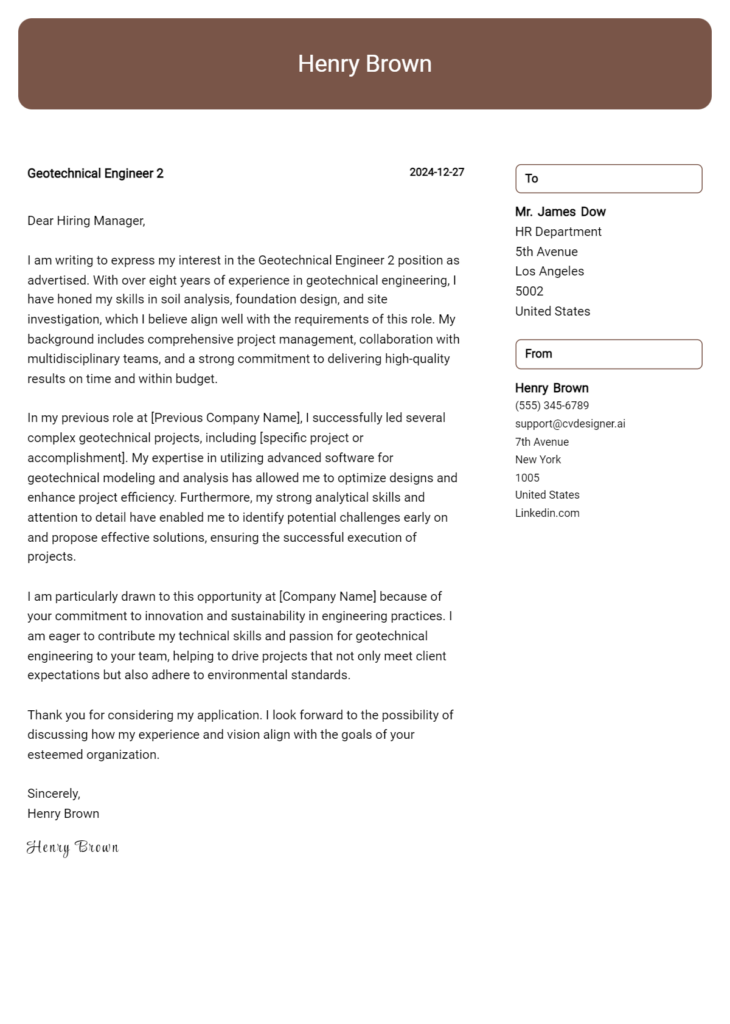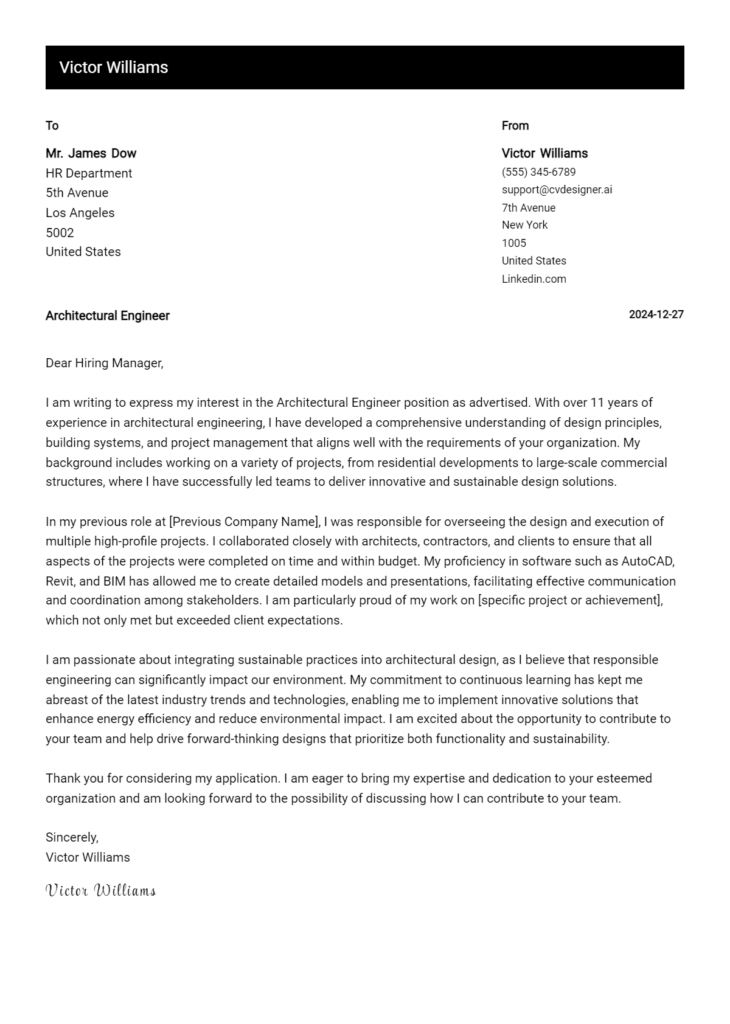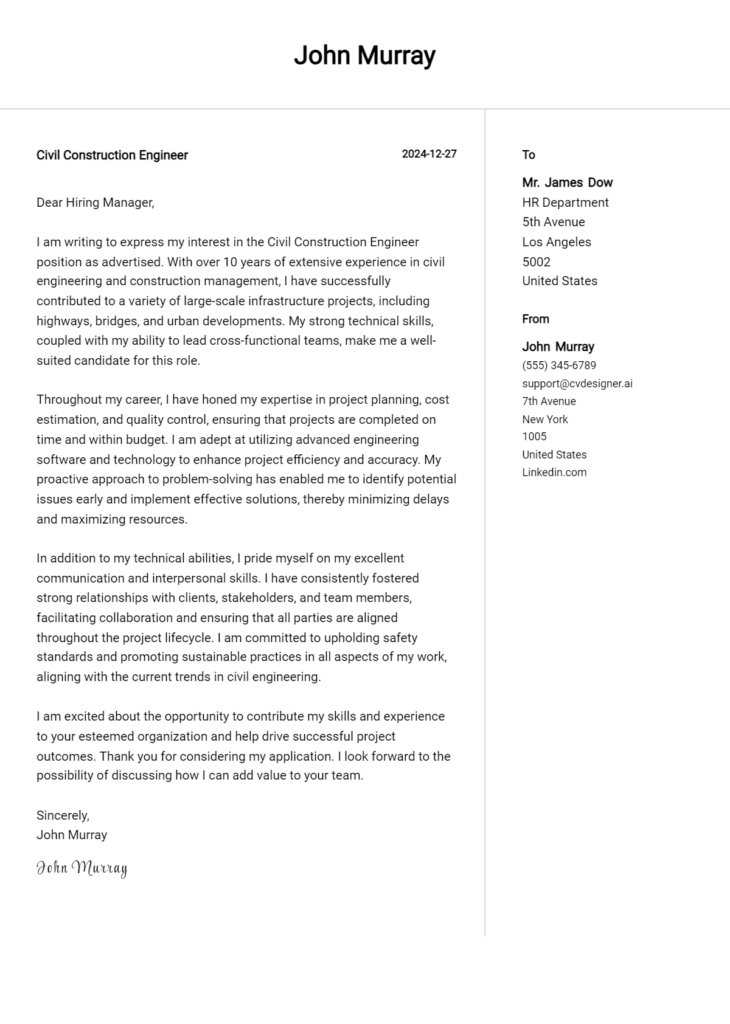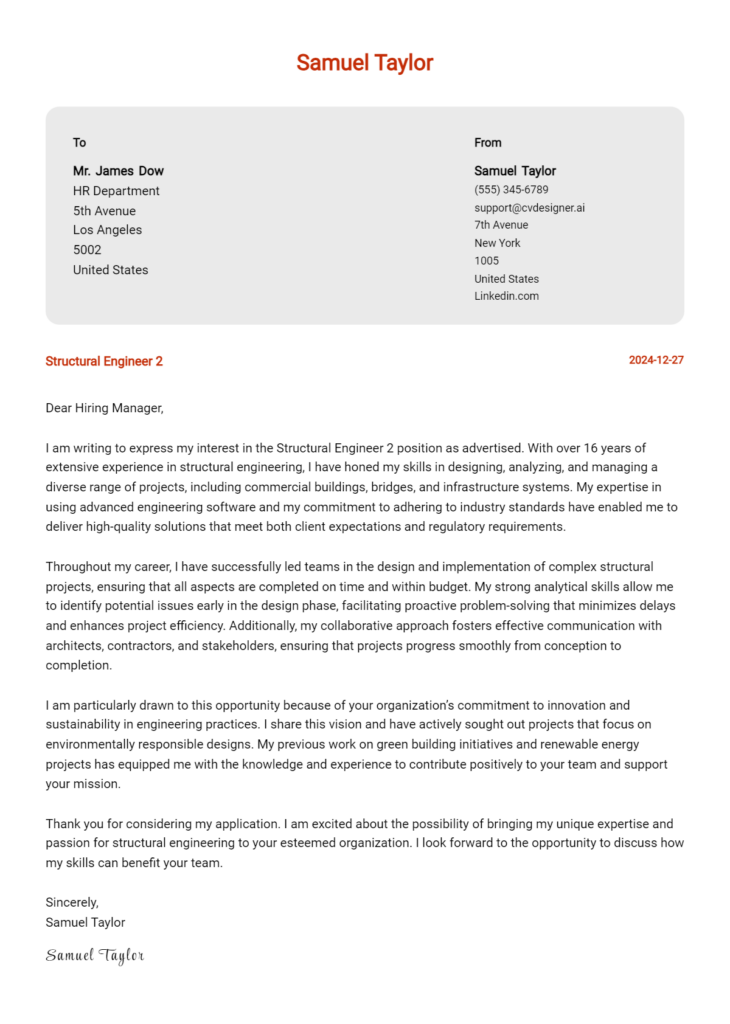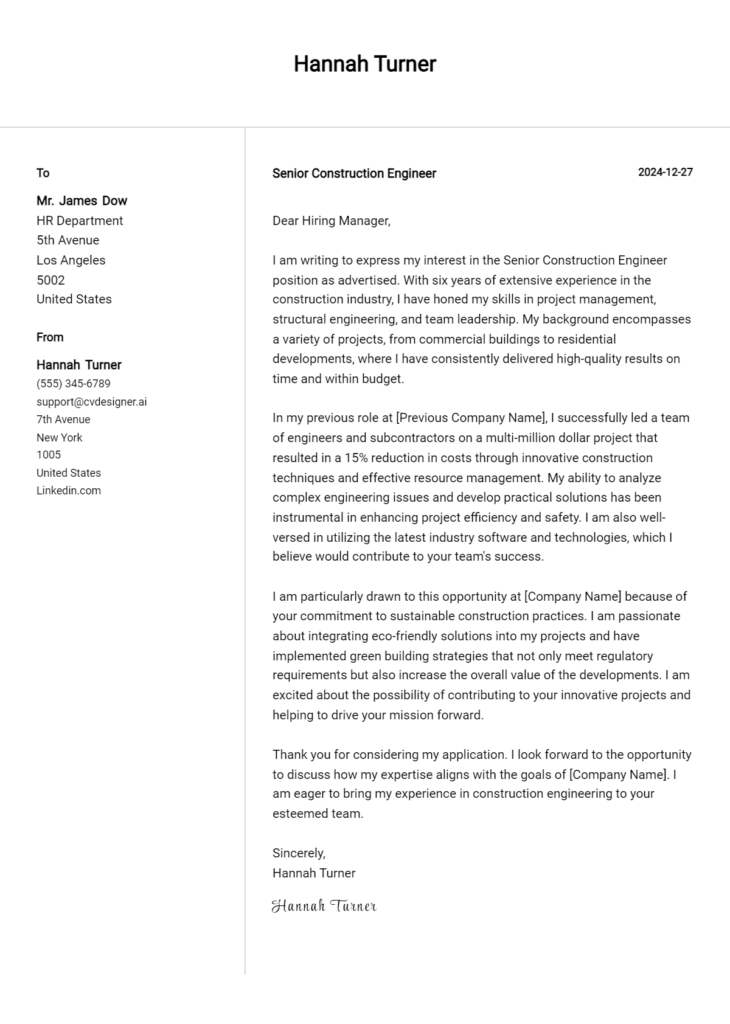Bim Engineer Cover Letter Examples
Explore additional Bim Engineer cover letter samples and guides and see what works for your level of experience or role.
How to Format a BIM Engineer Cover Letter?
Crafting a compelling cover letter is essential for a BIM Engineer, as it serves as a first impression that highlights your technical expertise and project management skills. Proper formatting not only enhances readability but also demonstrates your attention to detail—an essential trait in the Building Information Modeling field. A well-structured cover letter allows you to effectively convey your qualifications and enthusiasm for the role, making it easier for hiring managers to recognize your potential contributions to their projects.
In this guide, we’ll outline how to structure your cover letter, providing insights and BIM-specific examples to help you create an impactful document.
We’ll focus on the essential components of a professional cover letter, including:
- Cover Letter Header
- Cover Letter Greeting
- Cover Letter Introduction
- Cover Letter Body
- Cover Letter Closing
Each section plays a crucial role in showcasing your qualifications and professionalism. Let’s delve into each part to help your BIM Engineer cover letter stand out.
Importance of the Cover Letter Header for a BIM Engineer
The cover letter header is a critical component of a BIM Engineer's application, as it sets the tone for professionalism and clarity. A well-structured header provides essential information such as the applicant's contact details, the date, and the recipient's information. This not only ensures that the hiring manager can easily reach out but also demonstrates attention to detail—an important trait for a BIM Engineer. A clear and concise header reflects the applicant's organizational skills and professionalism, making a positive first impression.
Strong Example
John Doe 1234 Engineering Lane Cityville, ST 12345 (123) 456-7890 johndoe@email.com October 10, 2023 Hiring Manager ABC Construction Company 5678 Industry Road Cityville, ST 12345
Weak Example
john d. Cityville 10/10/23 To whom it may concern
Importance of the Cover Letter Greeting
The greeting of your cover letter is crucial as it sets the tone for the rest of your application. A strong greeting not only demonstrates your professionalism but also shows that you’ve taken the time to personalize your correspondence by addressing the hiring manager directly. This small but significant detail can make a lasting impression, indicating your genuine interest in the position and the company. To avoid sounding generic, it’s beneficial to research the recipient's name and title, which can often be found on the company’s website or LinkedIn. Using a specific name can elevate your cover letter, making it more engaging and thoughtful.
Strong Example
Dear Ms. Johnson,
Weak Example
To Whom It May Concern,
The Importance of a Strong Cover Letter Introduction for a BIM Engineer
A well-crafted cover letter introduction is crucial for a BIM Engineer, as it sets the tone for the entire application and can significantly influence a hiring manager's perception. The introduction should not only capture attention but also convey genuine interest in the role and the organization. It’s an opportunity to succinctly highlight key skills, relevant experiences, or notable achievements that align with the position’s requirements. A strong introduction can create a memorable first impression, while a weak one may lead to a missed opportunity. Below are examples illustrating the difference between an effective and a less effective introduction.
Strong Example
Dear [Hiring Manager's Name], I am excited to apply for the BIM Engineer position at [Company Name], as I am passionate about leveraging innovative building information modeling techniques to enhance project efficiencies and outcomes. With over five years of experience in the AEC industry, I have successfully managed multimillion-dollar projects utilizing Revit and Navisworks, which resulted in a 20% reduction in project timelines. I am eager to bring my expertise in collaborative design and data-driven decision-making to your esteemed team.
Weak Example
To Whom It May Concern, I am writing to express my interest in the BIM Engineer job. I think I would be a good fit because I have some experience with BIM software. I have worked on a few projects, but I am not sure how to quantify my achievements. I hope you consider my application.
Purpose of the Cover Letter Body for a BIM Engineer
The body of a cover letter for a BIM Engineer serves as a critical platform for candidates to articulate their unique skills, relevant experiences, and the value they can bring to a potential employer. This section is an opportunity to highlight specific projects or accomplishments that demonstrate proficiency in Building Information Modeling, collaboration with interdisciplinary teams, and the ability to enhance project efficiency through innovative solutions. A well-crafted cover letter body not only showcases technical expertise but also reflects the candidate's passion for the field and understanding of the company's goals, making it a vital component in securing an interview.
Strong Example
I am excited to apply for the BIM Engineer position at XYZ Corporation. With over five years of experience in the architecture and construction industry, I successfully led the BIM implementation for a $50 million mixed-use development project, which resulted in a 20% reduction in construction time and a 15% decrease in costs through enhanced coordination and clash detection. My expertise in Revit and Navisworks, combined with my commitment to sustainable building practices, has allowed me to contribute to projects that not only meet client demands but also adhere to environmental standards. I am eager to bring my skills in 3D modeling and data management to your team and help drive innovative solutions at XYZ Corporation.
Weak Example
I am applying for the BIM Engineer job. I have worked on some construction projects before and know how to use BIM software. I think I can help your company because I have some experience. I am a hard worker and believe I can learn quickly. I look forward to discussing my qualifications.
Importance of the Cover Letter Closing for a BIM Engineer
The closing paragraph of a cover letter is crucial as it encapsulates your qualifications, reiterates your enthusiasm for the position, and encourages the employer to take the next steps in the hiring process. A strong closing can leave a lasting impression, prompting the hiring manager to review your resume and consider you for an interview. Conversely, a weak closing may fail to convey your eagerness or the unique value you bring to the role, diminishing your chances of moving forward in the selection process.
Strong Example
I am excited about the opportunity to contribute to your team as a BIM Engineer, where I can leverage my expertise in Revit and AutoCAD to enhance project efficiency and collaboration. I believe my background in managing multidisciplinary teams and delivering high-quality projects aligns perfectly with your needs. I look forward to the possibility of discussing how I can add value to your organization. Please feel free to review my resume, and I hope to schedule a time for an interview soon.
Weak Example
Thank you for considering my application. I hope to hear from you soon. My resume is attached.
Crafting an effective cover letter for a BIM Engineer position is crucial for standing out in a competitive job market. A well-written cover letter not only introduces you to potential employers but also highlights your technical skills, problem-solving abilities, knowledge of the Software Development Life Cycle (SDLC), teamwork experience, and passion for continuous learning. To help you create a compelling cover letter, here are five detailed tips:
Tips for Writing a Cover Letter as a BIM Engineer
Showcase Your Technical Skills
As a BIM Engineer, you must demonstrate your proficiency in software tools such as Revit, AutoCAD, and Navisworks. Mention specific projects where you utilized these tools effectively. Add any certifications or training relevant to BIM and emphasize how your technical skills can contribute to the company’s projects.Highlight Problem-Solving Abilities
Employers value candidates who can address challenges effectively. Include examples of how you have identified and solved problems in past projects, such as coordinating with various disciplines to avoid conflicts or optimizing workflows. This showcases your analytical thinking and adaptability.Demonstrate Knowledge of SDLC
Your understanding of the Software Development Life Cycle is essential in BIM projects. Discuss your experience with different phases of the SDLC, particularly in how it relates to BIM methodologies. This will show your ability to integrate technology with project management processes.Emphasize Teamwork and Collaboration
BIM projects often require collaboration with architects, engineers, and contractors. Share experiences where your teamwork led to successful project outcomes. Highlight your communication skills and ability to work within diverse teams, as these are crucial for a BIM Engineer.Express Passion for Continuous Learning
The field of BIM is constantly evolving, and demonstrating a commitment to continuous learning is essential. Mention any recent courses, workshops, or conferences you’ve attended related to BIM technologies or methodologies. This shows potential employers that you are proactive about keeping your skills current.
By following these tips, you can create a compelling cover letter that effectively showcases your qualifications as a BIM Engineer. For additional assistance, consider exploring various cover letter templates or using a cover letter builder to streamline your writing process.
Common Mistakes to Avoid in a BIM Engineer Cover Letter
Crafting a compelling cover letter is essential for a BIM Engineer seeking to stand out in a competitive job market. Avoiding common mistakes can significantly enhance your chances of making a positive impression. Here are some frequent pitfalls to steer clear of:
Generic Content: Using a one-size-fits-all template can be detrimental. Tailor your letter to the specific job and company. Research the organization and mention relevant projects or values.
Lack of Specificity: Failing to highlight specific skills or experiences related to BIM can weaken your application. Clearly demonstrate how your expertise in software like Revit or Navisworks applies to the role.
Ignoring Formatting: A poorly formatted cover letter can be unprofessional. Follow a clear and structured cover letter format to enhance readability and presentation.
Overly Lengthy Letters: Keep it concise. Aim for a one-page letter that summarizes your qualifications effectively, avoiding unnecessary fluff.
Grammatical Errors: Typos and grammatical mistakes can make you appear careless. Proofread your letter multiple times, and consider using tools or a peer review for a fresh perspective.
Focusing on Responsibilities Rather than Achievements: Instead of just listing job duties, focus on your accomplishments and how you've added value in previous roles.
Neglecting a Call to Action: Always conclude with a strong call to action, expressing your eagerness for an interview and stating your availability.
By steering clear of these common mistakes, you can craft a more effective cover letter. For more insights, explore cover letter examples to guide your writing process.
Cover Letter FAQs for BIM Engineer
What should I include in my cover letter as a BIM Engineer?
In your cover letter as a BIM Engineer, highlight your technical expertise in Building Information Modeling and relevant software, such as Revit, AutoCAD, and Navisworks. Emphasize your experience in managing BIM projects, collaborating with architects and engineers, and ensuring compliance with industry standards. Additionally, mention any certifications or training related to BIM methodologies. Tailor your cover letter to the specific job description, showcasing how your skills align with the employer's needs. Don’t forget to express your enthusiasm for the role and the company, demonstrating your passion for advancing BIM practices in the construction industry.
How can I demonstrate my technical skills in my cover letter?
To effectively demonstrate your technical skills in your cover letter, use specific examples from your past experiences. Describe projects where you successfully implemented BIM processes, highlighting the tools and technologies you utilized. Mention any challenges you faced and how you overcame them, showcasing your problem-solving abilities. Quantify your achievements whenever possible, such as reducing project delivery times or improving collaboration among stakeholders. This not only illustrates your technical proficiency but also shows your ability to add value to the organization. Lastly, consider including a brief mention of your continuous learning efforts, such as attending workshops or obtaining certifications.
Should I customize my cover letter for each job application?
Yes, you should absolutely customize your cover letter for each job application. Tailoring your cover letter demonstrates your genuine interest in the specific position and company, which can set you apart from other candidates. Start by carefully reading the job description and identifying key responsibilities and required skills. Then, align your experiences and achievements with those requirements, using relevant terminology and examples. This shows that you've done your research and understand what the employer is looking for. Customization not only improves your chances of getting noticed but also allows you to convey how you can directly contribute to the success of the team and the organization.
How long should my cover letter be for a BIM Engineer position?
Your cover letter for a BIM Engineer position should ideally be one page long, consisting of three to four paragraphs. Aim for a concise yet impactful format that allows you to clearly communicate your qualifications without overwhelming the reader. Start with a strong opening that grabs attention, followed by a middle section where you detail your relevant skills and experiences. Conclude with a closing paragraph that reiterates your enthusiasm for the role and invites further discussion. Keeping it brief ensures that hiring managers can quickly assess your fit for the position while still providing enough information to entice them to read your resume.
Build your Cover Letter in minutes
Use an AI-powered cover letter builder and have your letter done in 5 minutes. Just select your template and our software will guide you through the process.

